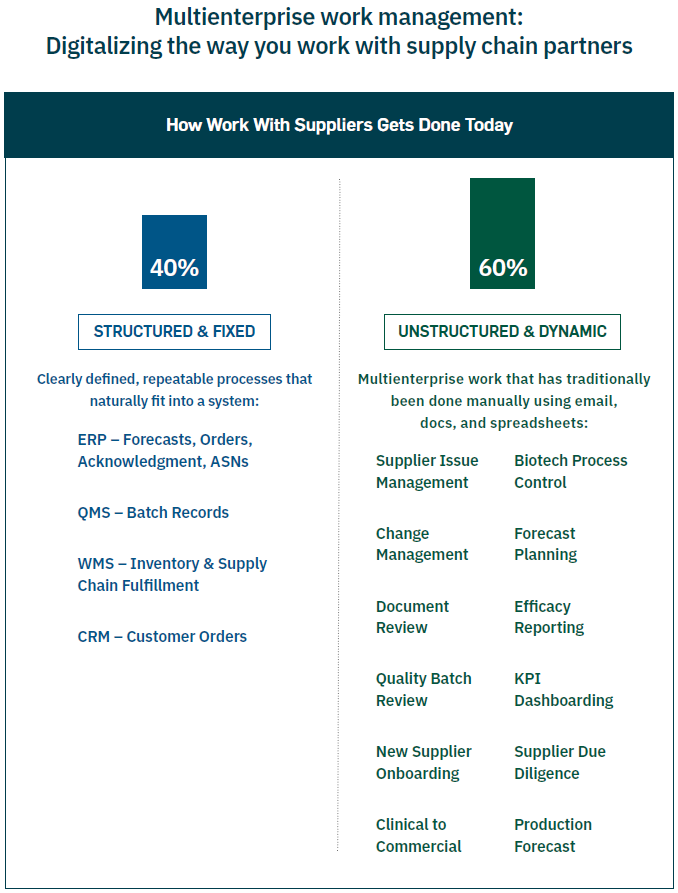Table of contents
Key Takeaways
- Multienterprise work management on a digital supply network can help your supplier relationship management team improve the quality of both products and business processes.
- A process network is a unique network consisting of stakeholders at supplier companies and key internal employees who work together to manage projects, execute changes, share documents, and resolve incidents.
- Supplier onboarding and due diligence is just one of the many supplier management processes you can digitally transform with multienterprise work management on a digital supply network.
February 11, 2021
One of the most important responsibilities of today’s pharma industry supplier relationship management teams is working with supplier networks to ensure both the quality of products and the quality of business processes.
It’s all about giving you greater visibility and more control so you can continually improve the quality of products and business processes across your entire supply network.
That means achieving consistent performance outcomes relative to benchmark goals for the delivery of products, processes, and services across all of your internal stakeholders and external supply partners. But managing quality issues with legacy communication and collaboration tools like phone calls and emails won’t scale as your supplier network continues to grow larger and more complex.
Multienterprise work management, a new type of network-based collaboration software designed specifically for the unique needs of pharmaceutical companies and their supplier networks, is the key to meeting and exceeding the pharma industry’s demanding quality standards.
Let’s take a look at just a few of the ways multienterprise work management software running on a digital network platform can digitally transform your supplier network and significantly improve the performance of your supplier relationship management team.
The power of process networks
Multienterprise work management software enables you to seamlessly connect key stakeholders from inside and outside your organization to collaborate on business processes and solve problems in a single, shared digital workspace. It runs on a network—but it also enables you to easily create networks within the network known as “process networks.”
A process network is a unique network of key stakeholders at supplier companies and internal employees who work together to manage projects, execute changes, share documents, and resolve incidents. Within the process network, you can drill down even deeper and create “process teams” of internal and external employees with domain expertise to resolve specific types of quality and business process defects.
When you create a process network, you can also assign specific solutions to it as needed. For example, you might decide to create a process network for all of your labeling and artwork providers. These companies often share their work in .pdf format. Therefore, it makes sense to assign document review capabilities to that process network.
Maybe you’ll choose to create a process network for your raw materials suppliers. Document review might not make sense for this process network, but incident management workflows would be useful when materials fail inspection.
It’s all about giving you greater visibility and more control so you can continually improve the quality of products and business processes across your entire supply network.
With multienterprise work management on a digital supply network, you can bring structure, workflow management, and greater accountability to previously unstructured processes. The chart below lists some of the typcial unstructured business processes that you can digitialize and gain greater control of right away with multienterprise work management.

A sea change in supplier onboarding and due diligence
Onboarding new suppliers and transferring production duties from one contract manufacturer (CMO) to another are major supplier relationship management challenges that require significant due diligence.
Your supplier relationship management team needs to make sure any new supplier meets your organization’s high standards for quality—and that generally involves an avalanche of emails, phone calls, spreadsheets, and document reviews. Does the supplier have the correct certificates? Are they following the right quality procedures? Does the CMO meet or exceed GxP standards? The list of questions that need to be answered as part of your due diligence goes on and on.
Keeping track of supplier onboarding and the related change requests that often accompany supplier document reviews gets much easier when it’s done in a shared virtual workspace that enables you to integrate with back-end systems, easily upload and share documents, and leverage customizable workflow-driven processes to exchange, review, and approve documents.
Supplier onboarding and due diligence is just one of the many general supplier management processes that you can transform with the right multienterprise work management solution. Additional examples include new product launches and tech transfers, addressing slowdowns in product review cycle times, and managing secondary sources of supply.
A more powerful way to tackle production quality challenges
Production quality problems like material defects or out-of-spec shipments are typically reported by the quality control team, entered into the quality control system, and partially managed there. But it’s often up to the supplier relationship management team to contact the supplier to determine why something went wrong and what needs to happen to improve the quality of the relevant production processes going forward.
Some examples of production management process challenges you can tackle with a network-based multienterprise work management solution include production slowdowns, schedule changes, supplier capacity problems, inaccurate planning and forecast changes, shipping delays, inventory shortages, material shortages, and lower than expected yields.
The bottom line? With multienterprise work management capabilities on a digital supply network, you can manage your entire ecosystem of suppliers.




